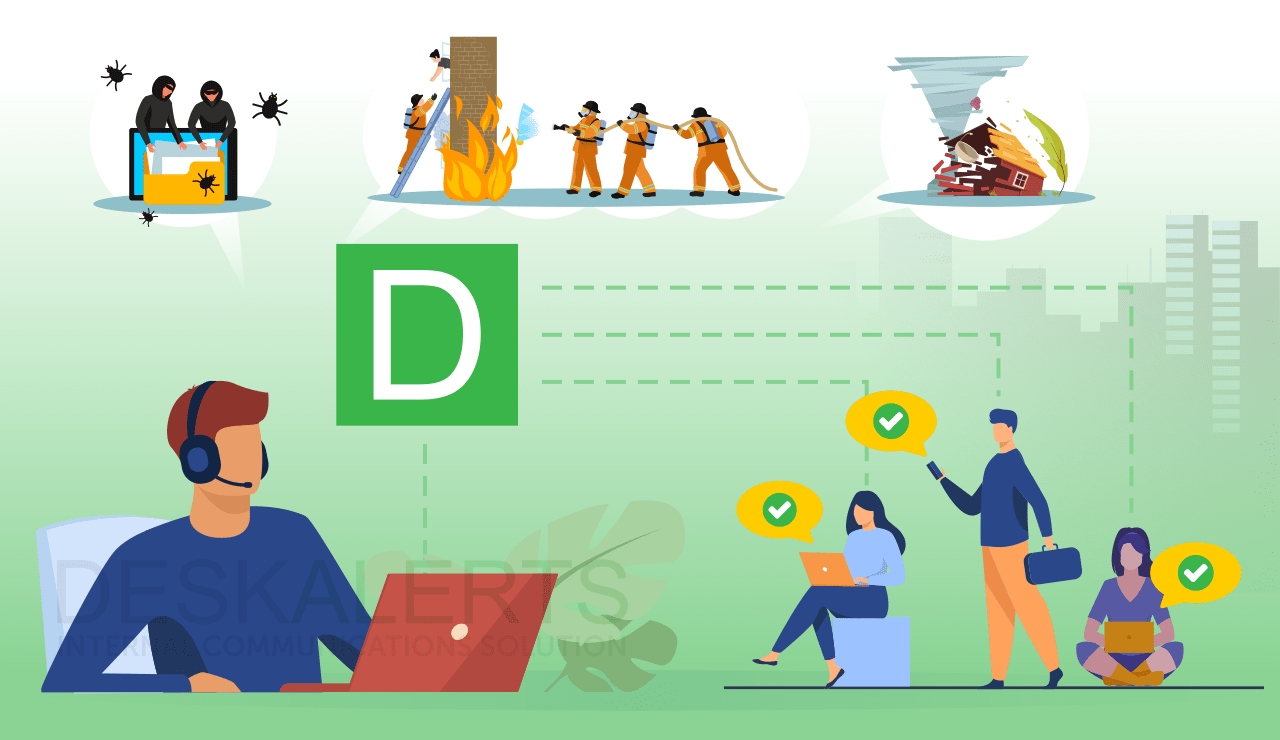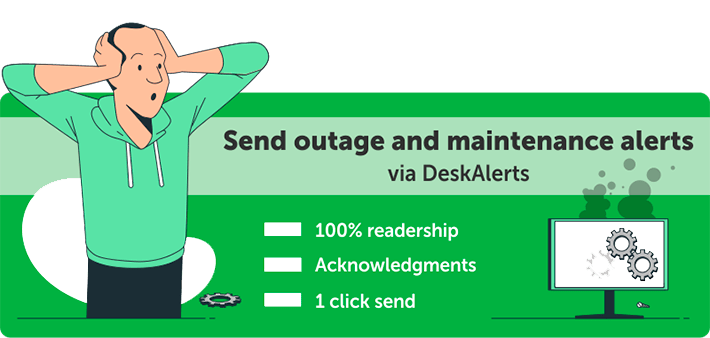
Major incidents are events that occur in an organization that are generally critical in nature and require urgent attention in order to remediate the problem. Each business will have its idea of what constitutes a major incident, but in general, they can be things like IT outages, power cuts, systems failures, inclement weather, and anything else that can harm your business operations.
By effectively communicating with your employees during a major incident, you can help to minimize the impact it will have.
Table of contents
1. The best practice for incident communications
2. The incident communication process: before, during and after
3. What to include in your incident response communications plan
4. Why you need the right tools for communication during an incident
The best practice for incident communications
When an incident takes place in your organization, communication is essential to navigate the way through successfully. Regardless of what is actually known – or unknown – about the incident, it’s vital to keep your employees informed every step of the way.
1. Respond to the issue quickly
Time is of the essence when you need to respond to a critical incident. You can’t wait around for lengthy approval processes when people need information about what is happening so that they can do their jobs or inform stakeholders. When there is a void in communication, speculation and rumors can quickly fill it, and misinformation can circulate as a result.
For this, you will most likely need specific tools, for example, IT outage notification software.

2. Communicate regularly with employees
Provide regular updates throughout the incident, whether the situation has changed or not. Let people know when they can expect the next update.
3. Communicate clearly and concisely
The information you send must be easy to understand, especially as people might be distracted by doing other things during the critical incident and not have time to decipher ambiguous or unclear messages.
4. Ensure what you are saying is consistent
Essentially, don’t say different things in different places at different times. If you are using a multi-channel approach to communication, the message should be the same regardless of the channel you are using. Additionally, if your critical incident needs to be communicated externally (for example, on social media with your customers or in the media). In that case, you should ensure you’re telling the same story you are telling internally.
5. Ensure honesty and transparency
You can do irreparable damage to your corporate reputation if you lie or if you are opaque with the truth when it comes to communicating this information. Within your company, it can cause a lack of trust and lower morale.
>> Learn more incident communication best practices <<
The incident communication process: before, during and after
Being prepared ahead of time to communicate when an incident takes place will not only save you time, but it can also save you from making mistakes that cost you financially and lose customers. Most incidents happen with little or no warning, but they do have a lot of elements that are the same, which enables you to plan ahead.
1. What to do before an incident
Your organization should have a critical incident response plan in place that includes internal communications, so you’re ready to hit the ground running when the unforeseen happens.
For internal communications, this means:
- Developing an incident response communications plan
- Determining who is responsible for communicating during an incident
- Determining which communications tools and channels you will use during an incident
- Developing pre-prepared message templates ahead of time that can be populated with the relevant information when an incident takes place
- Determine if there are different internal audience segments – for example, some employees may not be directly affected if your client booking system fails, but customer-facing employees will be. Analyze where the risk of an incident is and create audience segments as appropriate
- Test your incident response systems and processes regularly to ensure they work
2. What to do during an incident
Once you become aware of a critical incident, it’s time to spring into action and put your incident response communication plan in motion.
Quickly gather all the relevant information: What has happened? How did it happen? What is being done to mitigate it? When can a resolution be expected? Don’t worry if you don’t know everything yet; you can let people know that it is still being investigated.
- Populate your pre-prepared templates with the relevant information about the incident. Let people know if there is anything that is required of them during the incident.
- Send your messages via the communications channels you have previously selected.
- Monitor the situation and send regular updates either when new information is available or just to let people know that nothing has changed since your last notification.
- Ensure the information is going to the relevant employee cohort.
- You may need additional material, such as an FAQ, depending on the incident’s size and scale. For example, many companies had to develop these during the COVID-19 pandemic when the shelter in place orders would occur with little or no warning.
3. What to do after an incident
When the incident is over, it might be a case of business resuming as normal, or there may be a significant fall-out depending on what the incident was and the impact it had on your business’s ability to function.
- Communicate with employees about the impact of the incident on the short, medium, and long term (if appropriate).
- Communicate any business continuity measures that need to be implemented.
- Ask for feedback from employees about how the incident was handled – this evaluation can help you to fine-tune your incident preparedness plans for the future.
What to include in your incident response communications plan
An incident management communications plan will help you navigate the way through any incident, so you know when to communicate, what to communicate, and whom to communicate to.
Your plan should:
- Define what an incident means in your organization so you know what is a trigger point for it to be activated.
- Assign incident roles and responsibilities to know which employees have a role to play in providing and delivering the information.
- Contain key messages (or, at the very least, suggested key messages as you never know what will happen in an actual incident). These should be developed with a range of the most likely incident scenarios to affect your particular business in mind.
- Provide guidance on when to communicate and how often.
- Provide guidance on the internal communications channels that you should be using to deliver the information.
- Include a mechanism to measure the success of your communications.
Why you need the right tools for communication during an incident
When you need to communicate with your employees during an incident, you need the right tools for the job. Relying on email, for example, is not going to be enough. Emails are frequently ignored and unopened as people suffer from email overload in the workplace.
DeskAlerts is an internal communication software solution that is perfect for communicating with employees during an incident. It is designed to be deliberately intrusive in order to capture employees’ attention quickly and has a variety of delivery channels and other features to ensure they are informed throughout the incident.
This includes:
- Pop-up alerts will show on employees’ screens no matter what other software applications they are using at the time.
- The ability to send entire-screen alerts for a major incident that requires urgent attention.
- Scrolling desktop tickers that appear at the bottom of the screen can be used to provide updates on the status of the incident.
- The ability to reach employees no matter where they are located, in the office or working remotely or on the road via an employee app.
- The ability to produce pre-prepared incident response communication templates to save time during an incident.
- Being able to select custom audiences to send to. For example, if you have an outage affecting your company’s office in France, it won’t send to your employees based in the USA.
- Gathering feedback from employees via surveys with results in real time.
- The ability to provide training on what to do in an incident via a quiz module.
***
By being proactive now to ensure you’re ready to communicate with employees during an incident, you’ll be ready to hit the ground running when you need to. This is a good governance process and one you will be thankful you undertook should you ever need it.
 Caroline Duncan
Caroline Duncan








